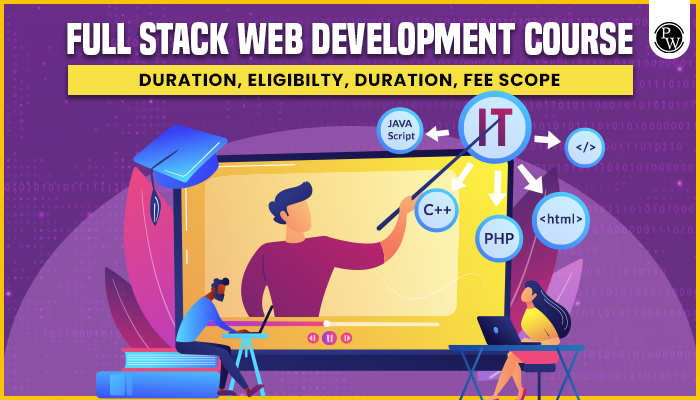This means that the course covers both the front-end development (client-side) and back-end development (server-side) aspects of web development.
Front-end development involves designing and developing the user interface, which includes the layout, design, and functionality of the website or application that users see and interact with. This typically involves using technologies such as HTML, CSS, and JavaScript.
On the other hand, back-end development involves working with server-side technologies such as databases, servers, and programming languages like Python, Ruby, or JavaScript to create the logic behind the scenes that makes the application function.
Recommended Course
- Generative AI Course
- Python DSA Course
- Devops Course
- UI UX Course
- Digital Marketing Course
- Product Management Course
The duration of a full-stack web development course can vary depending on the program. It can also vary on the level of expertise it is designed for. Generally, a full-time course can range from 12-36 weeks. At the same time, part-time programs can take anywhere from 6-12 months or more to complete.
Online self-paced courses allow you to learn at your own pace, which can take anywhere from a few months to a year or more, depending on your learning speed and schedule.
In addition, some universities and colleges offer full-stack web development courses as part of a degree program, which can take anywhere from two to four years to complete.
Also Read: Master the Art of Web Development with Decode Full Stack Web Dev 1.0
Full stack web Development Course Eligibility
The eligibility requirements for a full-Stack web development course can vary depending on the institution or organization offering the course. However, in general, the following qualifications may be required:
Educational qualifications
Enrolling in a full-stack web development course may require a minimum educational qualification: a high school diploma or equivalent. Some courses may require a bachelor’s degree or higher in a related field.
Programming knowledge
Enrolling in a full-stack web development course may require a strong understanding of programming languages like HTML, CSS, and JavaScript. Some courses may also require prior knowledge of frameworks like React or Angular.
Technical skills
Full-stack web development courses often require good technical skills, including proficiency in using development tools like Git, GitHub, and text editors.
Communication skills
Good communication skills are essential for full-stack web development courses. As a full-stack developer, you often work with cross-functional teams and must communicate with clients, stakeholders, and other team members.
Personal motivation
Full-stack web development courses can be intensive and require a high level of personal motivation and commitment to complete.
Fee for full stack web development course
The fee for a full-stack web development course can vary depending on the institution, duration of the course, and course content. Here are some examples of the fees charged by various institutions in India:
- Physics Wallah Full Stack Web Developer Course: 3500 INR
It is important to note that these fees are approximate and subject to change. Additionally, some institutions may offer scholarships or financial assistance to eligible students.
Also read: 5 Reasons to Become a Full-Stack Web Developer in 2023
Scope in full stack web development course
Full-stack web development is a broad field. This involves creating and maintaining websites or web applications from the client to the server. It covers all the aspects of developing a website or web application, from designing the user interface and coding the front end to implementing the back-end logic and database integration.
The scope of a full-stack web development course may include, but is not limited to:
- Front-end development: HTML, CSS, JavaScript, React, Angular, Vue, jQuery, Bootstrap, etc.
- Back-end development: Node.js, Python, Ruby on Rails, Java, PHP, Django, Flask, etc.
- Databases and data storage: MySQL, MongoDB, PostgreSQL, Oracle, etc.
- Server-side technologies: Nginx, Apache, AWS, Firebase, etc.
- Version control: Git, GitHub, GitLab, etc.
- Deployment and DevOps: Docker, Kubernetes, Continuous Integration and Deployment (CI/CD) pipelines, etc.
- Security: Authentication, authorization, encryption, etc.
- Testing and debugging: Unit testing, integration testing, end-to-end testing, debugging tools, etc.
A full-stack web development course may also cover software development methodologies, project management, and soft skills like communication and teamwork.
Also read: Web Development for Beginners: A Detailed Guide in 2023
Conclusion
Overall, a full-stack web development course aims to equip students with the knowledge and skills required to build and maintain web applications end-to-end, from the front end to the back end. It is a comprehensive course that covers a wide range of technologies and tools. This is a valuable asset for anyone interested in pursuing a career in web development.
FAQs
What skills do I need to learn for full-stack web development?
To become a full-stack web developer, you must know several programming languages. You must know frameworks such as HTML, CSS, JavaScript, React, Node.js, MongoDB, MySQL, and other front-end and back-end technologies.
Do I need prior programming experience to take a full-stack web development course?
Taking a full-stack web development course does not necessarily require prior programming experience. Course designers often include instruction on programming fundamentals and advanced concepts in full-stack web development so that it can be helpful but is not a requirement.
How long does it take to complete a full-stack web development course?
The length of a full-stack web development course varies depending on the course content and your own pace of learning. Some courses may take several months to complete, while others can be completed in a matter of weeks.
What job opportunities are available for full-stack web developers?
Full-stack web developers are in high demand, and job opportunities are available in various industries. Some job titles for full-stack web developers include web developer, software engineer, front-end developer, back-end developer, and full-stack engineer.

